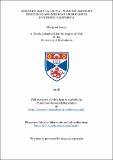Files in this item
Bailando bajo la lluvia : dancing amongst Mexicanos and Mexican Americans in Northern California
Item metadata
| dc.contributor.advisor | Bunn, Stephanie | |
| dc.contributor.author | Loney, Margaret | |
| dc.coverage.spatial | 325 p. | en_US |
| dc.date.accessioned | 2018-07-19T12:47:12Z | |
| dc.date.available | 2018-07-19T12:47:12Z | |
| dc.date.issued | 2018 | |
| dc.identifier.uri | https://hdl.handle.net/10023/15587 | |
| dc.description.abstract | This thesis is a study of dancing and dancing events amongst Mexicanos and Mexican Americans in northern California. The study posits that dancing can be approached as a broader form of activity which encompasses a variety of individual dance styles. In adopting this approach, the aim is to move the understanding of dancing away from a practice set apart from the everyday and used principally as a tool and site fo4r the construction and maintenance of identification, dancing instead emerges as an activity threaded through the everyday in a variety of forms, an activity in which practitioners engage for many varied and overlapping reasons throughout the course of their lives. Three principal themes are explored in the work. The first addresses the practitioners’ understanding of dancing and highlights the place of movement, music, and ‘sentir la música/el ritmo’ in this. This understanding is revealed to be flexible, multiple, and shifting, the result of attunement and responsiveness as the practitioners interacted with one another and the world around then, the second themes addresses learning and points to the presence of two different by interconnected experiences of dance enskilment, ‘learning to dance’ and ‘just dancing’. These are principally differentiated through the intent of the practitioners but are further differentiated through the understanding and sensory experience of the learning, the subject of enskilment and the value this is given, and dynamics between the practitioners. The third theme looks at dancing and dancing events as a relational process and explores the variety of relations, both those experienced as ‘positive’ and those as ‘negative’, that practitioners foster and articulate within dancing and how the explore a range of concrete activity before, during, and after dancing events to do so. Together these themes p-provide and understanding of dancing as a broader activity and process that complements work which focuses on individual dance forms and specific issues related to these | en_US |
| dc.language.iso | en | en_US |
| dc.publisher | University of St Andrews | |
| dc.subject.lcc | GV1624.7M49 | en |
| dc.subject.lcsh | Mexican American dance | en |
| dc.subject.lcsh | Dance--Anthropological aspects--United States | en |
| dc.subject.lcsh | Dance--Social aspects--United States | en |
| dc.subject.lcsh | Mexican Americans--California--Social life and customs | en |
| dc.subject.lcsh | Mexicans--California--Social life and customs | en |
| dc.subject.lcsh | Music and dance | en |
| dc.subject.lcsh | Quinceañera (Social custom) | en |
| dc.subject.lcsh | Salsa (Dance) | en |
| dc.subject.lcsh | Bachata | en |
| dc.subject.lcsh | Reggaetón | en |
| dc.title | Bailando bajo la lluvia : dancing amongst Mexicanos and Mexican Americans in Northern California | en_US |
| dc.type | Thesis | en_US |
| dc.contributor.sponsor | Russell Trust | en_US |
| dc.type.qualificationlevel | Doctoral | en_US |
| dc.type.qualificationname | PhD Doctor of Philosophy | en_US |
| dc.publisher.institution | The University of St Andrews | en_US |
This item appears in the following Collection(s)
Items in the St Andrews Research Repository are protected by copyright, with all rights reserved, unless otherwise indicated.

